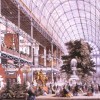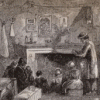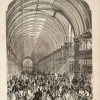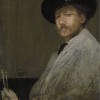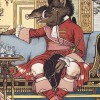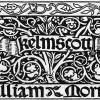Exhibitions
Created by Dino Franco Felluga on Tue, 05/12/2020 - 09:20
Part of Group:
Exhibitions
Timeline
Chronological table
| Date | Event | Created by | Associated Places | |
|---|---|---|---|---|
| 1 May 1851 to 15 Oct 1851 |
Great Exhibition
The Great Exhibition of 1851 was an event in the history of: exhibitions; world’s fairs; consumerism; imperialism; architecture; collections; things; glass and material culture in general; visual culture; attention and inattention; distraction. Its ostensible purposes, as stated by the organizing commission and various promoters, most notably Prince Albert, were chiefly to celebrate the industry and ingeniousness of various world cultures, primarily the British, and to inform and educate the public about the achievement, workmanship, science and industry that produced the numerous and multifarious objects and technologies on display. Designed by Joseph Paxton, the Crystal Palace (pictured above) was a structure of iron and glass conceptually derived from greenhouses and railway stations, but also resembling the shopping arcades of Paris and London. The Great Exhibition of the Works of Industry of All Nations became a model for World’s Fairs, by which invited nations showcased the best in manufacturing, design, and art, well into the twentieth century. ArticlesAudrey Jaffe, "On the Great Exhibition" Related ArticlesAviva Briefel, "On the 1886 Colonial and Indian Exhibition" Anne Helmreich, “On the Opening of the Crystal Palace at Sydenham, 1854″ Anne Clendinning, “On The British Empire Exhibition, 1924-25″ Barbara Leckie, “Prince Albert’s Exhibition Model Dwellings” Carol Senf, “‘The Fiddler of the Reels’: Hardy’s Reflection on the Past” |
Dave Rettenmaier | ||
| 12 Jul 1851 |
Queen Victoria visits the Exhibition Model Dwellings
ArticlesBarbara Leckie, “Prince Albert’s Exhibition Model Dwellings” Related ArticlesBarbara Leckie, “‘The Bitter Cry of Outcast London’ (1883): Print Exposé and Print Reprise” |
Dave Rettenmaier | ||
| 29 Apr 1854 |
Exhibition of French Paintings at Pall Mall
The exhibition was organized by the art dealer Ernest Gambart and held in the space that would soon become known as the French Gallery. The exhibition marked the first instance of a recognizably modern commercial art gallery, a development that profoundly changed the physical, economic and social relationships between artists, dealers, art objects and viewers. ArticlesPamela Fletcher, “On the Rise of the Commercial Art Gallery in London” |
Dave Rettenmaier | ||
| 10 Jun 1854 |
Sydenham Crystal Palace opensOpening of the Crystal Palace at Sydenham on 10 June 1854. Image: The Crystal Palace on fire (30 November 1936; author unknown). This image is in the public domain in the United States because its copyright has expired. The resurrection of the Crystal Palace of 1851 in its new setting at Sydenham, with an expanded architectural complex and enhanced functional brief, embodies the Victorian emphasis upon visuality as a means of acquiring and conveying knowledge. In addition, the new Crystal Palace was shaped by prevailing concepts of rational recreation and beneficial commerce that insisted that private and public interests could be simultaneously satisfied and lead to a stronger nation and even Empire. ArticlesAnne Helmreich, "On the Opening of the Crystal Palace at Sydenham, 10 June 1854" Related ArticlesAudrey Jaffe, "On the Great Exhibition" Aviva Briefel, "On the 1886 Colonial and Indian Exhibition" Anne Clendinning, “On The British Empire Exhibition, 1924-25″ |
Dave Rettenmaier | ||
| 5 May 1857 to 17 Oct 1857 |
Manchester Art Treasures ExhibitionFrom 5 May to 17 Oct 1857, the Manchester Art Treasures Exhibition occurred. This was an art exhibition in temporary buildings at Old Trafford, organized by leading Manchester figures and supported by Prince Albert. The exhibition was notable for focusing purely on fine art, for using information about works owned privately contained in Gustav Waagen’s Art Treasures of England (1843)—the organizing committee often solicited specific works from donors—and for hanging both Old and Modern Masters chronologically. It was attended by over 1.3 million visitors over 5 months and helped spur interest in making art accessible to a wider public. Articles
|
Dave Rettenmaier | ||
| 5 May 1857 to 17 Oct 1857 |
Art Treasures of the United Kingdom Exhibition
Related Articles |
Dave Rettenmaier | ||
| 25 May 1857 to 25 Jun 1857 |
Pre-Raphaelite Art Exhibit
Related Articles |
Dave Rettenmaier | ||
| May 1877 |
Grosvenor Gallery inaugural exhibition
Articles |
Dave Rettenmaier | ||
| May 1877 to Jul 1887 |
Crane exhibits at Grosvenor
ArticlesJulie Codell, "“On the Grosvener Gallery, 1877-90″ Morna O’Neill, “On Walter Crane and the Aims of Decorative Art” |
Dave Rettenmaier | ||
| 4 May 1886 to 14 Oct 1886 |
Colonial and Indian Exhibition
Featuring extravagant displays from British colonial holdings, the exhibit was organized by the Prince of Wales as an “imperial object lesson” in England’s power and grandeur. ArticlesAviva Briefel, "On the 1886 Colonial and Indian Exhibition" Related ArticlesAudrey Jaffe, "On the Great Exhibition" Anne Helmreich, "On the Opening of the Crystal Palace at Sydenham, 10 June 1854" Anne Clendinning, “On The British Empire Exhibition, 1924-25″ Erika Rappaport, “Object Lessons and Colonial Histories: Inventing the Jubilee of Indian Tea” |
Dave Rettenmaier | ||
| 1 Oct 1888 |
First Arts & Crafts exhibition
ArticlesImogen Hart, “On the Arts and Crafts Exhibition Society” Morna O’Neill, “On Walter Crane and the Aims of Decorative Art” |
Dave Rettenmaier | ||
| 15 Nov 1888 |
"Letterpress Printing" lecture
|
Dave Rettenmaier | ||
| 24 Feb 1893 |
Opening of Grafton GalleriesOn 24 February 1893, Grafton Galleries were opened on Grafton Street, London. The gallery held temporary exhibitions of British and international fine and decorative art. ArticlesMeaghan Clarke, “1894: The Year of the New Woman Art Critic” |
Dave Rettenmaier | ||
| 1 May 1893 to 30 Oct 1893 |
Columbian Exhibition, ChicagoFrom 1 May 1893 to 30 October 1893, the Columbian Exhibition was held in Chicago. The exhibition had a Women’s Pavilion and the World’s Congress of Representative Women was held there on 15 May 1893. ArticlesMeaghan Clarke, “1894: The Year of the New Woman Art Critic” Carol Senf, “‘The Fiddler of the Reels’: Hardy’s Reflection on the Past” |
Dave Rettenmaier | ||
| 12 May 1911 |
Festival of Empire
Located at the Crystal Palace, Sydenham, the Festival of Empire, originally scheduled for 1910 but postponed due to the death of Edward VII, was a physical manifestation of imperial rhetoric. British colonies and dominions were represented by three-quarter size replicas of their Parliamentary buildings housing exhibits of products of those countries as well as scenes recreating the physical environment of select locales, such as a Maori village. The Festival of London, part of the Festival of Empire, featured historical pageants and reinforced London’s role as the chief locus of empire ArticlesAnne Helmreich, "On the Opening of the Crystal Palace at Sydenham, 10 June 1854" Related ArticlesAviva Briefel, "On the 1886 Colonial and Indian Exhibition" Anne Clendinning, “On The British Empire Exhibition, 1924-25″ |
Dave Rettenmaier | ||
| 2 Apr 1924 |
British Empire Exhibition opens
ArticlesAnne Clendinning, “On The British Empire Exhibition, 1924-25″ Related ArticlesAviva Briefel, "On the 1886 Colonial and Indian Exhibition" Anne Helmreich, “On the Opening of the Crystal Palace at Sydenham, 1854″ |
Dave Rettenmaier |

